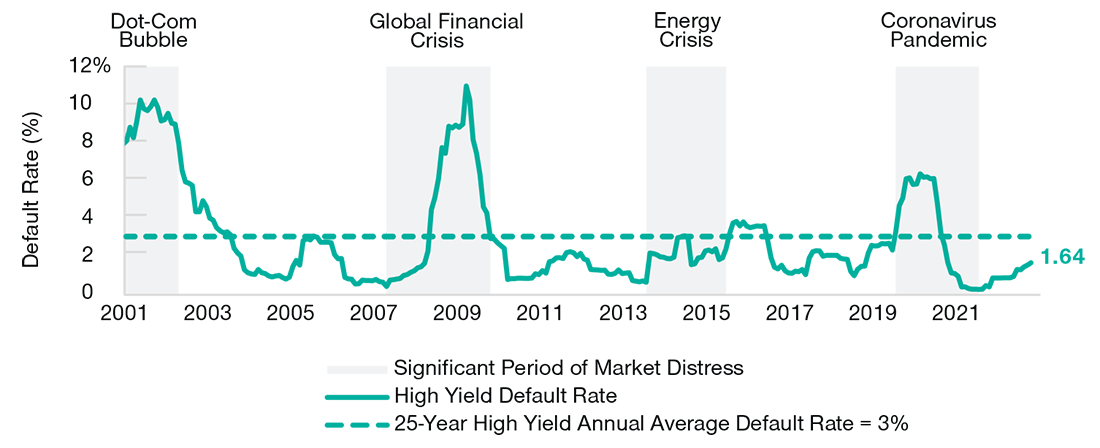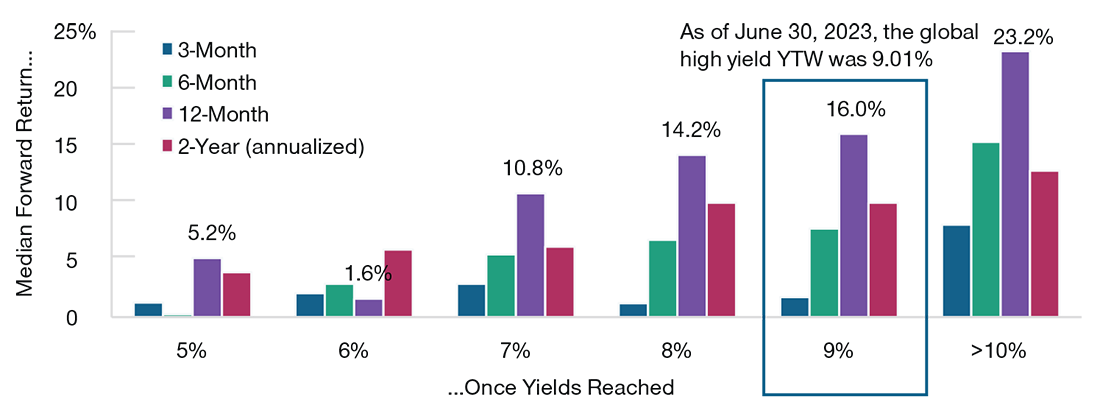This asset class has only seen 7 years of negative returns since 1980
Key Insights
- The global high yield market has performed well across different market cycles, thanks to high coupons and a return to par at maturity.
- Issuer fundamentals have remained resilient despite the challenging macro backdrop.
- Improved credit quality is paired with the most attractive yields available in over a decade.
Why High Yield Bonds?
It has produced durable returns over time
Global high yield bonds have broadly performed favourably across different market cycles. Since 1980, the high yield market has only experienced seven calendar years of negative returns. Perhaps even more impressive is that there have never been two consecutive years of negative returns in the asset class covering 40 years (Fig. 1).
High Yield Bond Annual Returns
(Fig. 1) Only seven negative return years since 1980.

Source for annual returns data: J.P. Morgan Global High Yield Index.
Following years of negative returns, the asset class usually experienced years of either outsized gains or several years of modest returns. This resilient return pattern is simply due to “bond math.” The high yield market may experience bouts of weakness, resulting in lower dollar prices; however, it still generates high coupons, and eventually bonds are pulled to par as they near maturity, fortifying the returns recovery.
Leveraged credit has generated compelling risk-adjusted returns
While return is certainly an important consideration when evaluating an asset class, volatility must also be evaluated. The Sharpe ratio, which measures return in excess of the risk-free rate, per unit of standard deviation, can be a useful metric to compare risk-adjusted returns across asset classes. Over the last 10 years, high yield bonds have had the second-highest risk-adjusted returns, trailing only below investment-grade bank loans (Fig. 2). Consequently, we believe that investors have been fairly compensated for the additional performance risk when moving to below investment-grade credits.
Low default rate profile
Although the macro backdrop remains challenging for risk assets, high yield fundamentals continue to be resilient. Since the global financial crisis (GFC), high yield market new issuance has been dominated by refinancing as issuers capitalised on historically low interest rates. Additionally, record capital markets activity in 2020 and 2021 (post-COVID drawdown) at cheap financing rates strengthened balance sheet liquidity and increased interest coverage metrics to peak levels. The high yield default rate marginally increased to 1.6% in June 2023 from 0.8% in December 2022 but remains well below its long-term average of 3% (Fig. 3).
Statistics Across the Markets
(Fig. 2) High yield compares favourably to other segments.

Global High Yield Market Default Rates
(Fig.3) Defaults are running below the historical average.

Why High Yield Bonds Now?
Evolution to a higher credit quality market
The current high yield market is drastically improved compared with the GFC in terms of credit quality. Using the Credit Suisse High Yield index as a proxy, the high yield market has migrated up considerably in credit quality since the GFC. In 2007, only 37% of the index had at least one BB rating; today, that figure is roughly 60% (Fig. 4). Partially the result of record fallen angel volume (USD 240 billion) entering high yield in 2020, the average company in the high yield market has a larger market cap and generates more free cash flow today than prior to the GFC. Therefore, we feel the asset class is in a position of strength should the economic outlook weaken.
Today’s yields have rarely been observed over the last 10 years
Rate and credit spread volatility since the first quarter of 2022 have resulted in attractive yields and dollar discounts not seen since the GFC, attributed to unprecedented quantitative tightening and related recession fears. As of June 30, 2023, the yield to worst on the J.P. Morgan Global High Yield Index was north of 9%. This is well above the average level of 6.86% observed over the last 10 years (Fig. 5). Considering the credit quality of the market is much higher today, the absolute yield on the asset class screens attractive, especially compared with similar dislocation levels during the energy crisis (2015–2016) and the pandemic sell-off, where both the quality and fundamentals of the market were lower than levels observed today.
BB Composition of the High Yield Market
(Fig.4) High yield credit quality has steadily improved.

Yield to Worst of the High Yield Market
(Fig.5) Attractive yields given higher credit quality.

Yields indicate attractive valuation
While we cannot predict future returns from current yields, we can use history as a baseline for when the high yield market had similar yield levels and what forward, or subsequent, returns looked like. Since 2012, the high yield market has crossed the 9% yield threshold five times. In each instance, the one-year forward return picture has been in the mid-double-digit range (Fig. 6). Since 2012, the median 12-month forward returns have been in double digits when yields in the market have exceeded 7%.
Historical Global High Yield Returns Once Yields Reached Various Thresholds
(Fig. 6) History provides a baseline for similar yields.

Invest with confidence
T. Rowe Price focuses on delivering investment management excellence that investors can rely on—now and over the long term. Hit the 'follow' button below for more of our investment insights.
.png)
5 topics
1 fund mentioned

